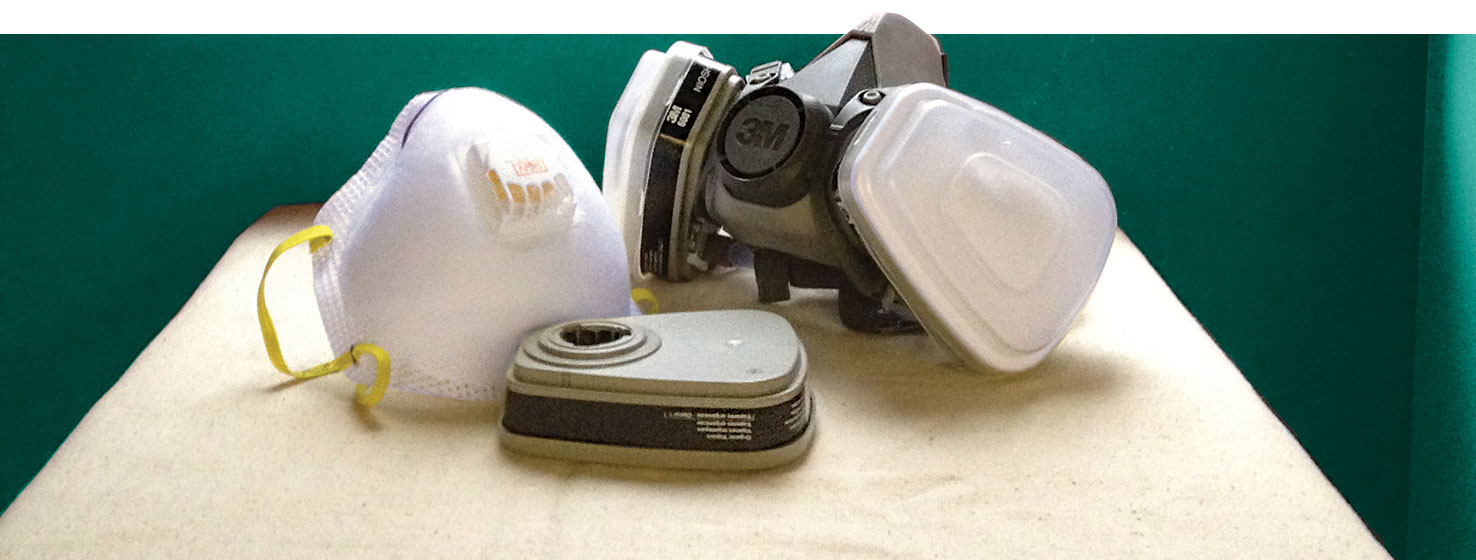Which Chemical Requires The Use Of A Fresh Air Makeup System Respirator?
The pro painter'south guide to respirators
By Jason T. Lunn & Rebecca 50. Schumann
We know. Yous're anxious to go the job washed. You're busy. And wearing a respirator is non your first priority.
But stop, exhale and think for a minute.
If you're employing people who paint, you are responsible for the health and safe of your employees, including controlling hazards in the workplace and making certain your people wear personal protective equipment like respirators.
If you're a painter, do the right affair for yourself and wearable a respirator to protect your lungs from exposure. Considering even though many paints and coatings meet the most stringent VOC regulations, inhaling chemicals and hazardous dusts can yet occur.
First with air monitoring
Begin with cognition about your potential exposure and what you might be up against. Air monitoring can assistance quantify concentrations. This could include monitoring for grit or for certain chemical components in pigment products. It could as well include specific hazards like lead, mold or asbestos in renovation piece of work.
How do you become about monitoring your work environs? There are a number of different ways to go about it, including contacting OSHA Consultation (Non the enforcement side of OSHA) to bring someone out to monitor the air and provide guidance, going through a third-party Industrial Hygiene consultant to comport the air sampling, going through your take chances insurance company, or you could fifty-fifty do it yourself if y'all are competent in industrial hygiene sampling methods.
A mask or a respirator?
This is a mutual question, merely the difference between a mask and a respirator is extremely important. A "mask" is not designed to keep fine grit out of your deep lungs. Masks have not undergone any government filtration performance testing. They are intended to keep the larger particles out of your oral fissure.
In contrast, a respirator has filter media and forms a tight seal to the face to reduce your exposure to airborne particulates. To be called a "respirator," the filtering facepiece must be NIOSH approved and state the NIOSH rating (such as N95) on the product.
Making the correct choice
The option between a dispensable filtering facepiece respirator and a reusable cartridge respirator relates back to your exposure assessment and what kind of protection y'all demand, so brand sure you understand what hazards you'll be exposed to for a particular chore.
Disposable respirators
When you lot hear the term "disposable respirator," think protection confronting particle exposures, not chemic exposures. Some disposable respirators do offering a layer of carbon in the media to assistance reduce exposure to some odors, but it'due south not enough carbon to bargain with chemical exposures that are exceeding OSHA's Permissible Exposure Limits (PELs).
Disposable respirators tend to exist more than comfortable than their reusable counterparts considering of their lighter construction. They cost less, crave no maintenance and are simply thrown away at the end of their service life.
Reusable respirators
When yous're dealing with chemical exposures that exceed OSHA's Permissible Exposure limits (PELs), select a reusable respirator with the advisable chemical cartridge. Reusable respirators are versatile since they offer the pick of choosing a particle filter or chemical cartridge.
Chemic cartridges incorporate activated carbon to help reduce exposure to a variety of unlike chemical types, depending on the NIOSH approval rating.
The carbon inside the cartridges is treated for different chemic types. Because of the many different chemicals y'all may be exposed to, there are a variety of chemical cartridge options designed for specific applications. They are color coded to help with selection.
Some cartridges let you to add a particulate prefilter, so yous can assistance filter out both particulates and gases/vapors. Reusable respirators also take the selection of using particulate filters only which can attach to the reusable facepiece straight.
Reusable respirators require regular maintenance and cleaning and take a college initial toll than disposables, but they may save money in the long run when the facepiece is reused and the cartridges and filters are simply replaced.
When properly fit and sealed to the face, a dispensable respirator and a half facepiece reusable respirator offer the same level of protection for the worker. OSHA has assigned them both a protection factor of ten. This means they protect confronting particulate contaminant concentrations up to ten times the occupational exposure limit.
This article was written by Jason T. Lunn, Senior Technical Service Engineer, and Rebecca L. Schumann, Industrial Hygienist, Technical Service, at 3M Condom Products. If you're a small business organization owner and would like assistance with respiratory compliance, you lot tin can contact 3M for a "Respirator Option Guide" and several "Habiliment It Right" posters for your crews' reference. Simply call one-800-494-3552.
Source: https://www.sherwin-williams.com/painting-contractors/business-builders/paint-technology-and-application/sw-art-breathe-easier
Posted by: boothereastill.blogspot.com


0 Response to "Which Chemical Requires The Use Of A Fresh Air Makeup System Respirator?"
Post a Comment